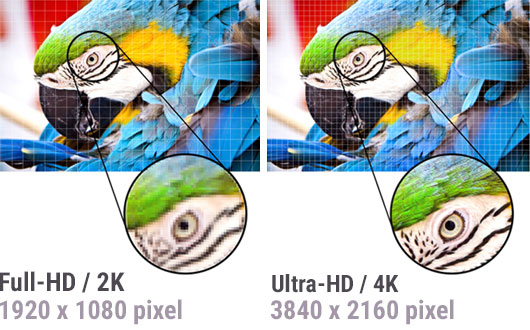What is 4K Resolution Monitor?

In the world of technology, display resolution is a key factor. It determines the clarity and detail of images on screens. Among the various resolutions, 4K stands out. But what exactly is a 4K resolution monitor?
A 4K resolution monitor offers a display with 3840 x 2160 pixels, which totals approximately 8.29 million pixels. This is four times the pixel count of Full HD (1920 x 1080), which has about 2.07 million pixels. The result is sharper, more detailed images. This makes 4K monitors ideal for large screens, typically 27 inches and above, where clarity and lifelike visuals are crucial. They are popular among gamers, graphic designers, and video editors. These users benefit from the enhanced detail and clarity. 4K monitors also support HDR, offering better color and contrast. This enhances the viewing experience for both work and entertainment. As 4K content becomes more available, these monitors are increasingly in demand. They represent the future of display technology and are widely utilized in consumer electronics, professional photography and video production, gaming, and medical imaging.
What is 4K Resolution?
4K refers to a horizontal resolution of around 4,000 pixels. A pixel, short for “picture element,” is the smallest unit of an image. The more pixels an image contains, the higher its resolution and the better its quality.
4K resolution describes video images with roughly 4,000 horizontal pixels. A 4K Ultra HD TV has a resolution of 3840×2160 pixels, which is four times that of Full HD (1920×1080 pixels), delivering sharper details and richer colors.
In most cases, 4K refers to a 3840×2160 resolution. The terms “4K” and “UHD” are often used together to describe this resolution. In the digital cinema industry, however, DCI 4K (4096×2160 pixels) displays are used, which are also referred to as 4K displays. For everyday home media use, 4K UHD already offers excellent quality.
Two Types of 4K
3840×2160 pixels (4K Ultra HD)
4K UHD is defined by the ITU (International Telecommunication Union). Its horizontal and vertical resolutions are both twice those of Full HD, and it has been widely adopted in the television industry.
4096×2160 pixels (DCI 4K)
DCI 4K is defined by the Digital Cinema Initiatives (DCI). It has a slightly higher horizontal resolution than 4K UHD. This resolution is exactly double that of the standard projector resolution (2048×1080 pixels) and is used in the film industry.
4K Monitor Resolution vs. Other Resolutions
- • HD (720p): 1280 x 720 pixels
- • Full HD (1080p): 1920 x 1080 pixels
- • 2K QHD (1440p): 2560 x 1440 pixels
- • 4K UHD: 3840 x 2160 pixels
4K monitor resolution vastly improves image detail and clarity. Compared to 1440p, it provides twice the pixel count, making text sharper and images more vivid. The benefits of 4K become even clearer on larger screens, allowing viewers to sit closer without seeing individual pixels.
| Designation | Info |
| SD (Standard Definition) | 720 x 576, aspect ratio 16:9 |
| HD (High Definition) / 720p | 1280 x 720, aspect ratio 16:9 |
| Full-HD (Full High Definition) / 1080p / 2K | 1920 x 1080, aspect ratio 16:9 |
| Ultra-HD (Ultra High Definition) / 4K / UHD / UHD-1 | 3840 x 2160, colloquially also known as 4K Ultra-HD |
Why Use 4K Resolution?
Having a 4K display means you can enjoy more high-quality content and a richer viewing experience. With an ultra-high definition resolution of 3840×2160 pixels, a 4K monitor offers higher pixel density, delivering sharper images with details that are clearly visible.
A 4K monitor with HDR support can display more vivid and accurate colors compared to non-HDR models. HDR-enabled 4K displays provide a deeper level of immersion, higher contrast, and a better close-up viewing experience.
The high resolution of 4K is ideal for large screens— even when sitting very close, individual pixels remain clearly distinguishable. This feature is crucial for home theaters and immersive viewing setups. As we’ve discussed, 4K resolution brings unmatched clarity to your screen, with vibrant colors and crisp details.
Key Features and Benefits of 4K Monitors
They also offer:
- • Better viewing experiences on large screens
- • Future-proofing as 4K becomes the industry standard
- • Immersive visuals for gaming, movies, and design work
4K Content Availability: Movies, Games, and More
FAQS
What is the meaning of 4K resolution?
4K resolution refers to a display with approximately 4,000 horizontal pixels, providing high detail and image clarity.
What resolution is 4096x2160?
4096x2160 is known as DCI 4K, primarily used in the film and video production industry.
Is 4K 3840x2160 or 4096x2160?
4K can refer to both; 3840x2160 is standard 4K UHD for consumer media, while 4096x2160 is DCI 4K for professional cinema.
Is 3840x2160 true 4K?
3840x2160 is often referred to as 4K UHD, widely accepted as "true 4K" in consumer electronics, though it has slightly fewer pixels than DCI 4K.
Is 2160p 4K or 2K?
2160p is synonymous with 4K UHD, referring to the vertical resolution of approximately 2160 pixels.
What is pixel density?
Pixel density measures the number of pixels per inch (PPI) on a display, indicating how closely pixels are packed together.
What is the pixel density of 4K?
The pixel density of a 4K display varies based on screen size, but it significantly exceeds that of standard HD displays, offering sharper and clearer images.
Is higher pixel density better?
